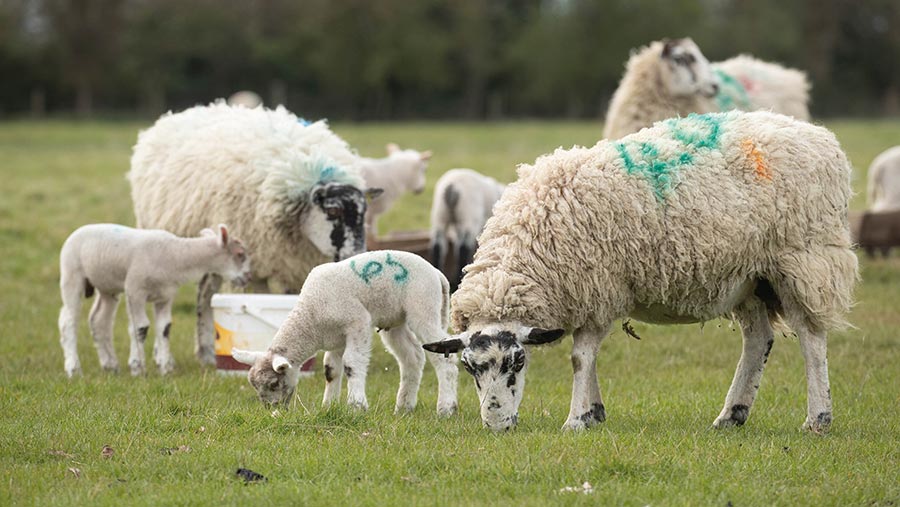Outlook 2023: Tight sheepmeat supplies set to support prices
 © Tim Scrivener
© Tim Scrivener The outlook for sheepmeat prices in 2023 remains generally positive, despite domestic demand coming under pressure in the year ahead due to the cost-of-living crisis.
Lamb is an expensive meat. However, worldwide supplies remain tight and demand from key UK export markets such as the EU, Asia and US seems firm.
That will hopefully offset, at least to some degree, any reduction in demand by domestic consumers and help underpin the price, says Andersons director David Siddle.
See also: 10 top tip for aspiring sheep farmers
Sheep summary
- Positive price outlook for sheepmeat in 2023 as tight global supplies help offset reduced domestic demand
- Lamb supply has increased in 2022, but further growth next year is likely to be limited
- The sheep sector has been heavily supported for many years, but will soon become fully exposed to market returns – this will increase the focus on commercialism
UK imports from New Zealand and Australia have been at historically low levels for a few seasons now.
This is partly due to a reduction in flock sizes in these countries, but also because they are focusing on the Asia-Pacific region, especially China.
That has undoubtably helped drive UK prices upwards. However, there are signs of a slowing in Chinese demand.
In addition, these markets are not always the most stable, with non-economic trade barriers being introduced with little or no warning, for example.
The UK breeding sheep flock increased by 3% in 2022 to 14.5 million ewes. With a generally good lambing season, the lamb crop increased to an estimated 17.9 million head.
Late autumn saw sheepmeat prices still well above historic levels, with the market appearing capable of absorbing a modest increase in supply despite the economic headwinds.
Costs will limit expansion
Rising input costs, winter fodder shortages following drought in many areas in 2022 and attractive cull ewe prices are likely to limit any further significant increase in the breeding sheep flock in 2023.
A further effect of drought and lack of grass growth in 2022 may be reduced lambing percentages in the year ahead. Poor summer nutrition and high concentrate costs may have left ewes in less-than-ideal condition for the breeding season.
Domestic agricultural and environmental policy looks likely to have a significant effect on the future size and structure of the UK sheep flock following the UK’s departure from the EU.
This may be seen most immediately in England with the phase-out of the basic payment on which much of the industry has historically depended.
The new environmental schemes are likely to favour lower stocking densities.
The sheep sector has been heavily supported for many years.
However, with the phasing out of the basic payment in England by 2027, and ag inflation reducing the real-terms value of remaining payments across all devolved regions, the sector is becoming rapidly exposed to what returns can be generated from the market alone.
This is bringing a focus on commercialism, which many more traditional producers have been able to avoid to date.
One effect could be an increasing move away from the traditional stratified three-tiered breeding structure that has existed in the UK for many years.
Hill and upland pressure
The first tier based on the high hills and pure hill breeds – for example, Blackface, Swaledale and Welsh Mountain – looks likely to come under most pressure.
This is due to negative margins, excluding support, and the fact much of this land looks to have an increasing environmental value, which may offer more lucrative returns than sheep farming.
On the middle ground, where draft or regular aged ewes traditionally produced cross-bred ewe lambs to be used in the lowlands, some more progressive businesses are already replacing these flocks to rear finished lambs.
They are often based on composite breeds, and techniques such as performance recording, pasture improvement, modern grazing techniques, outdoor lambing, low labour and machinery costs and rigorous selection policies are common.
Many of these flocks report some impressive financial returns compared with the average.
On the low ground we see more flocks moving away from the reliance on purchasing replacement crossbred ewe lambs and gimmers to closed flocks involving fewer animal movements and reducing the risk of disease spread.
The use of home-bred replacements of known disease status and the ability to select stock for commercial traits such as ease of lambing, longevity, milk production, backfat depth, birthweights, lamb growth rates and disease resistance can bring significant economic benefit.
There is much talk of the integration of sheep in particular into more regenerative farming systems.
While a few more sheep are appearing on arable farms, most of the UK flock will remain in the uplands or based on permanent pasture and long-term leys.
It is the economic performance of these sheep that will need to improve if they are to remain a viable enterprise in the future.
